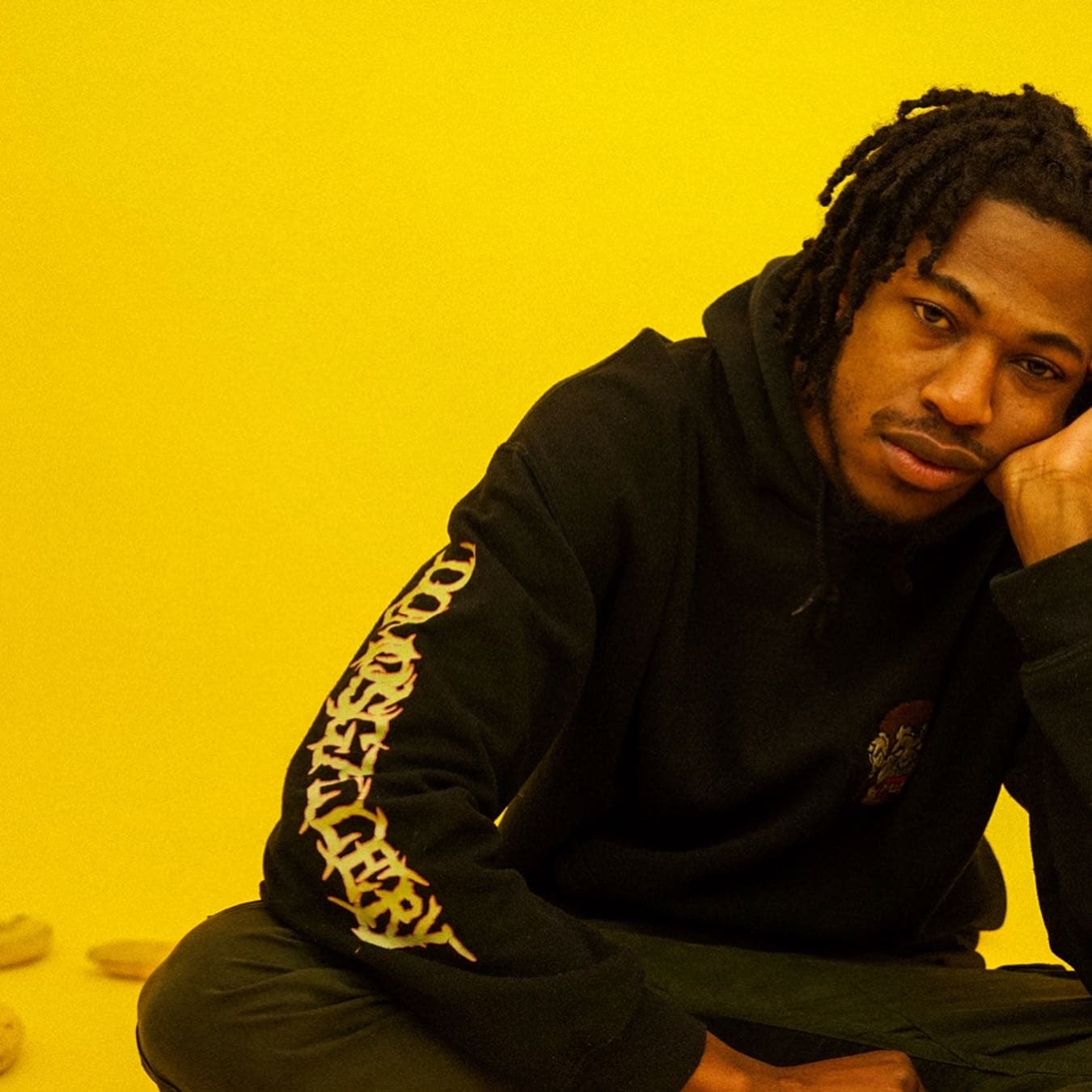
Introducing: Domo Gorille
Tice Cin interviews rapper, artist and designer, Domo Gorille. Domo Gorille recently released his EP ‘The Sublime’, it’s atmospheric, bassy, and comes with big messages about self-discovery, coping with pain and transcendence.
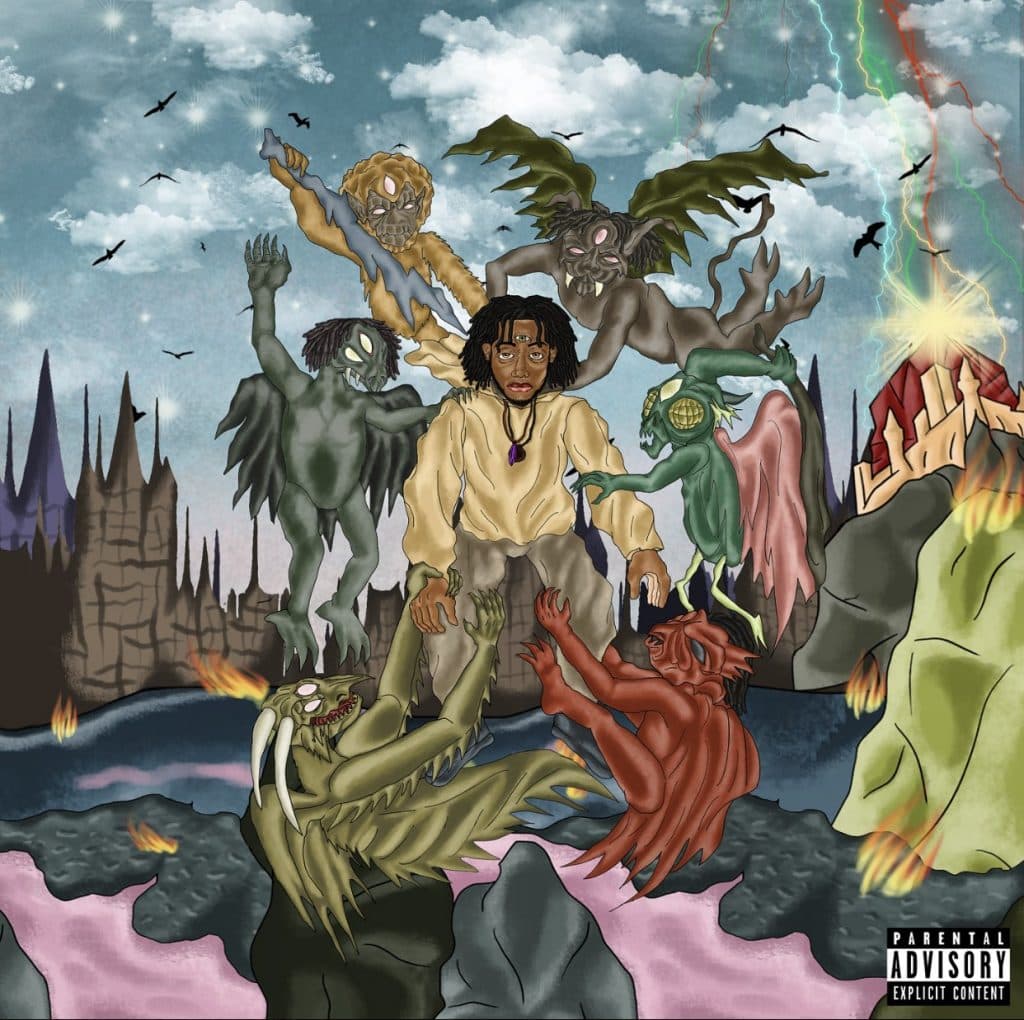
Cover for ‘The Sublime’
Tice Cin: So what were the seeds for this project?
Domo Gorille: It started with Pain into Millions in early 2017, after a crazy year for me and all of my friends, so much had happened. It was the first solo song I had made since my teen years of music. I’ve been making music with Denzel Nonso (from Afro Comb) and other people from Enfield such as TMJuelz & Ferno. But it would always be songs that had multiple people on it and not own my own, so in my eyes PiM was the first. From 2017 onwards I had it in mind to turn into a project and start to see which songs pieced together, in that time I grew a lot as an artist.
Pain into Millions – Domo Gorille
TC: You have a cool alt-psychedelic aesthetic to your work, drawing inspirations from gods, demons and psychedelia. This really shines in your animated video for Pain into Millions, could you tell me more about your process?
DG: The PiM animated video was actually a uni project at first! In the last stretch of uni, I wanted to learn animation urgently. I’d paid so much for uni that I had to get something substantial out of it! So I asked my teacher to help me learn and it took me three months on After Effects etc. And I already had it in mind that it was for a song so I thought I’d hit two birds with one stone – do my uni project and do the song’s visuals…
The message behind the song needed surreal art to help depict the emotive behind the tune. The message behind the song/animation is about someone who has lost their way and they want to regain their sense of sense, my character goes through a journey and they have so many obstacles on their way like the monkey on his back. I want my visuals to be just as impactful and meaningful as the lyrics I spray. As I keep going on this journey I’m not going to lower the standards, things are only gonna get better. I want people to view my videos and feel like they can’t contain themselves!
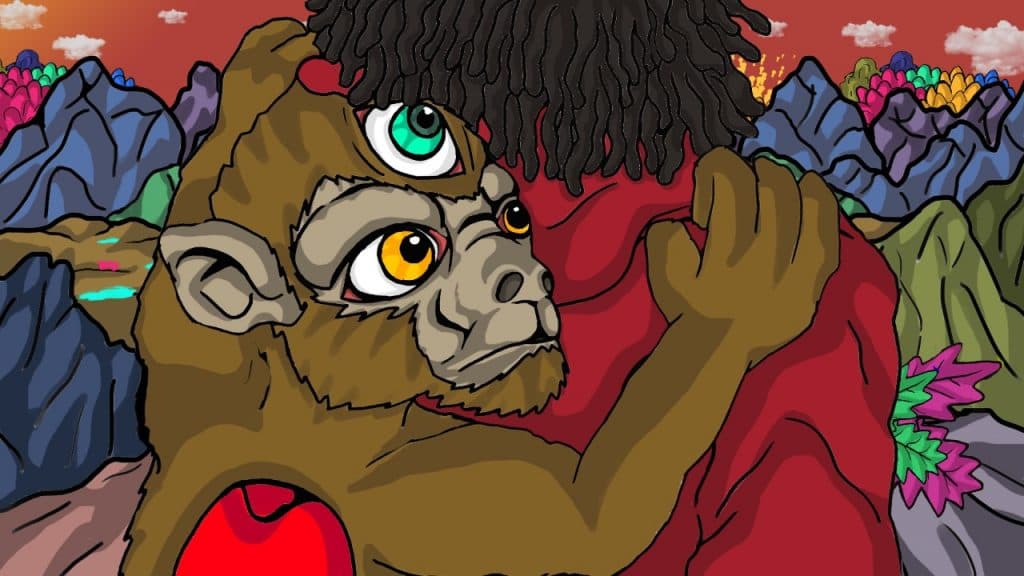
Still from ‘Pain into Millions’
TC: That line in PiM, ‘Monkey was stuck to my back like a demon’ feels part of a series of abstract explorations of mental health and the pressure to keep up in your music. We see artists like Isaiah Rashad actively talking about mental health, and the positive impact of that. I feel like the way you do collaborations but also just generally, your songs are like you’re sitting down to have a chat with a friend and give them advice.
DG: It’s quite weird because I feel like that’s a topic I subconsciously talk about – I never want to feel like I’m being too preachy but I am trying to talk about mental health in an organic way, people have come back to me saying that they feel a sense of awareness about their feelings through my music which I’m really happy about.
Sometimes I talk to my friends about toxic masculinity too which links, in music there are certain vibes that are off – like I haven’t got the type of girl tunes that celebrate toxic behaviour cause that’s not my mind-set. Maybe if you go back to when I was 16 and it was all ego and bravado then maybe, but not at all nowadays.
Ocean’s Verge by Domo Gorille feat Denzel Nonso
TC: I’m curious about how you’ve developed your sound. In the past you’ve described it as ‘psychedelic trap sound, which is 808 driven’…
DG: During recent years, I feel like my sound is becoming more solid and what people perceive me to be as an artist feels true to me a person. If my choice of beats weren’t so bassy I think I’d be easily branded as a socially conscious rapper. My sound is quite trappy in terms of instrumentals, and euphoric. I really love a good core-shaking baseline. I call it neo-psychedelic rap – like my art style! As I get to work more closely with producers then I can evolve the sound more. I’m trying to work with a lot of producers this year to catch a vibe and go on a journey with.
In terms of rapping where I’m from, in London (north), it feels like I’ve got a bit of an underground sound. That’s in comparison to drill, or even gangster rap that feels more influential around certain areas in north – especially in the 2010s – cause they speak to gang culture here in a specific way (not to mention how classic grime still sounds in north).
In places like south and east, I feel like there’s been a youthful artistic culture bubbling over the years that allows space for risk taking. There needs to be more community spaces in north (in places like Enfield) where people can get creative, like NTS Radio’s WIP program at Ten 87 Studios and Bernie Grant Arts Centre.
Music is so social too, depending on what kind of social circles you’re in, it can either benefit you or make your career progression harder. I know how much this depends on networks and resources. We need to build up the community.
When I was younger I used to compare myself to certain artists (this was fuelled by ego, and unproductive) until I realised that everyone has their own journey and might struggle to get to the top, like myself. When I locked into my own energies and focused on my individuality, it all changed. Something that helped me develop that was by heading to open mics and performing. Working with platforms like The Pit London have helped my process a lot when it comes to this. Also being able to have an outlet to talk and discuss life stuff with people like The Fhumly podcast. I’m someone who loves to learn from people who have a lot of knowledge, so I think about mentorship in this industry a lot and how much that would be helpful if I had a mentor behind me.
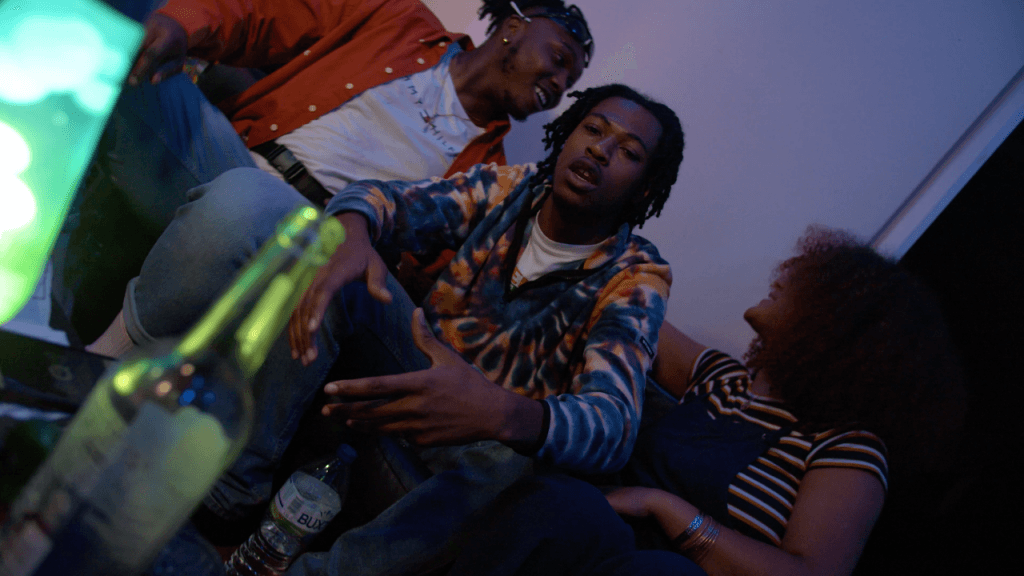
‘Community’
TC: I wanted to dig a bit deeper with your thinking around the sublime and surrealist imagery in your work. What’s the pulse of that for you?
DG: There’s a few things, for instance, I was in a relationship with someone super spiritual and rooted, who taught me things about a higher sense of consciousness and how we perceive ourselves. That opened my eyes up a lot and helped me align myself and change my perspective on things, which gave me a real boost during my late teens. To doing things like trying LSD at like eighteen with my mates too…after the trip you end up with mad morals, and discover the answers to so many questions in your mind! My work is also inspired a lot by artists like Alex Grey because his work is experimental and quite visionary psychedelic realism, informed by many different religions and spiritual teachings.
TC: I’ve seen you do some art that feels so hyper realistic that it then goes off into an uncanny surreal space, there’s a self-portrait of you on your bed that got me.
DG: That painting I called it ‘Fryers and Smoke’, it was actually for my good friend Richard’s exhibition Fixation at The Who gallery, based on addiction and how people perceive addiction. I think a lot about how eyes in paintings are the key to the soul, which is what I was trying to emulate with that painting.
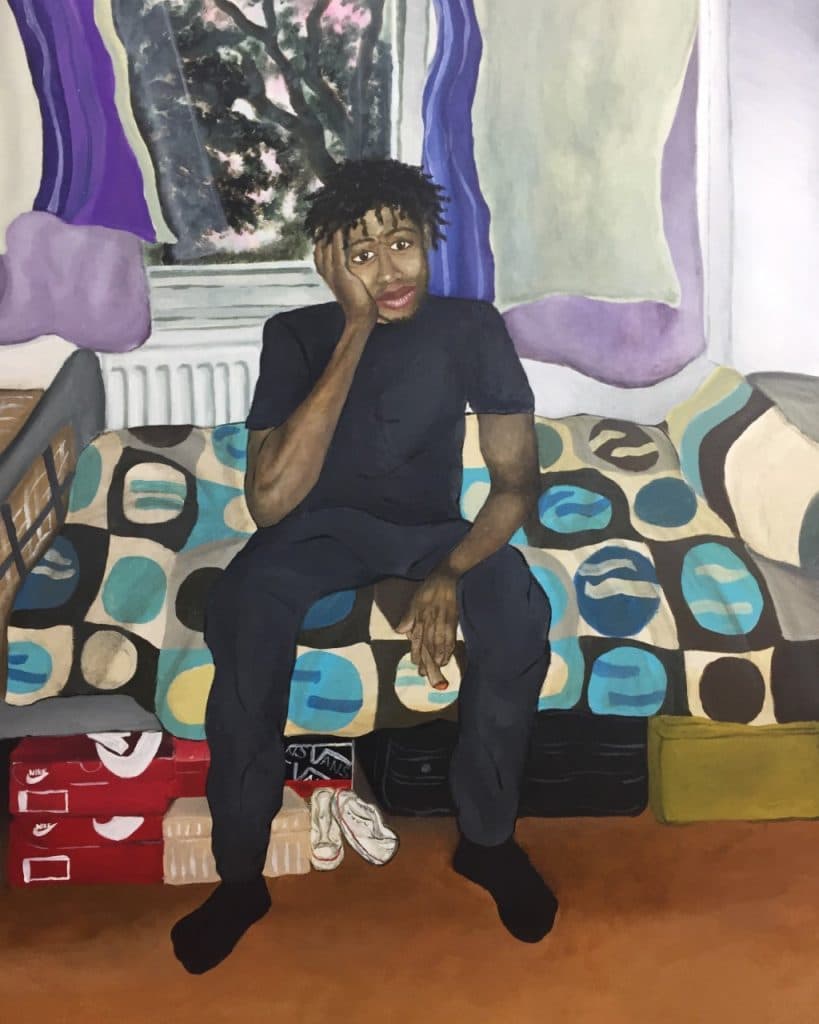
Fryers and Smoke
TC: What are your other inspirations and hopes?
DG: One big inspo would be my dad who was a graphic retoucher, he was supposed to go to uni, but his dad basically told him that men don’t do art so he didn’t go to Central Saint Martins. He later saw an ad in the newspaper for graphic retouching, he went there and was a natural at colour correcting without even using the equipment. He got the job and stopped in the late 80s/early 90s when Apple products came in so he was one of the artists that didn’t transition into the digital age. I do what I do because of him. Even in music, he has a huge archive of vinyl and CDs – a lot of his genes have imprinted on me. It’s weird, I feel like I’m almost the reincarnation of him because us pursuing the same passions.
I’ve been quite independent when it comes to my art, brand representation and visual work for music launches etc. Once I solidify myself within music and in art, in years to come I want to form a creative team of artists, photographers, videographers, visual effects and motion designers; something like A$AP Rocky’s creative collective. I’ve already built an aesthetic so I’d love to share that with other talented and committed creatives.
TC: I was listening to an interview of yours where you lot started talking about Dragon Ball Z in your art: ‘We all used to draw Super Saiyans’. This is such a thing! Even in The Pit London’s 2020 cypher, one of the other artists mentioned Super Saiyan in their set. Do you think there’s something about our generation of artists and a collective imagination around transformation? I’m thinking Pokemon evolving, and Goku’s Super Saiyan…
DG: We grew up watching anime and Dragon Ball Z, after primary you’d go straight in and watch that on Tsunami on Cartoon Network. And then go trace the characters through the light of the windows! The age of technology was TV. We weren’t using Internet and YouTube so when your resources are limited it starts to get you to think in different ways, and we digested things differently. Imagine how this changes the way you create… I think this applies to the whole generation that I grew up with, the super saiyan level up lines are heavily used in rap music.
‘The Pit LDN Ones to Watch Cypher 2020’
TC: How do you see the link between growing into a more intensely digital age, dance/ skanking and UK rap?
DG: We grew up with music off our Sony Erikson’s etc. In school you’d be playing tunes, skanking about and seeing all the dance moves that come about through hip-hop and rap, or funky house – Migraine skank, all of these different skanks. Any way that I can let off steam and express is good for me.
I wanna dance more in my videos. I love to dance. Whenever I go out with my friends they use me as their token dancer, ‘Where’s Dom? Go dance’ whenever we’re partying etc. In the US, dance culture within rap (like their drill scene right now for example) is cool because they’re road but very lively and expressive through dance; we’re starting to see this more in the UK. In my next video people gon’ see these moves!
TC: What have you got coming up?
DG: Hyperspeed. More music, more visuals, a new collection of merch with Domo’s Gallery and hopefully a headline show this year. I’m putting out a music video from the Sublime EP, it’s the main song off the project!
Follow Domo Gorille on Instagram and Twitter
Author:
Tice Cin is a writer and maker of spacey beats, currently working on digital art at Barbican as part of Design Yourself collective. She shares news of her work on Instagram and Twitter
Back to home.